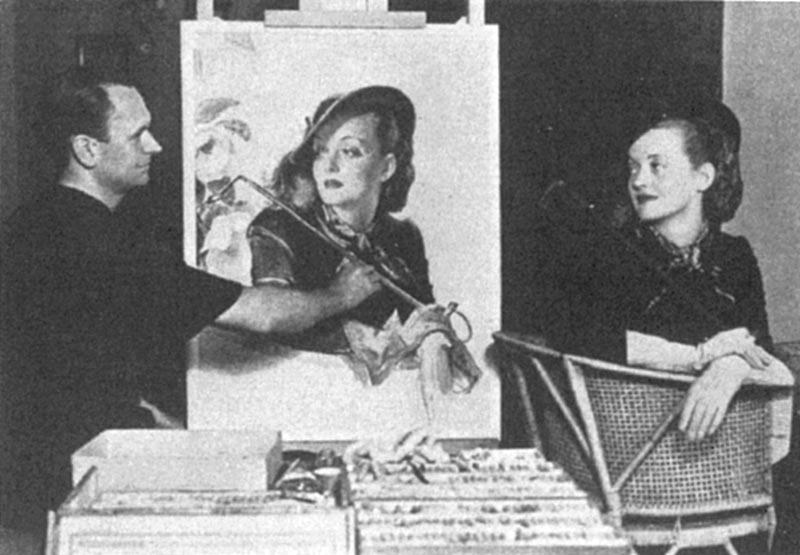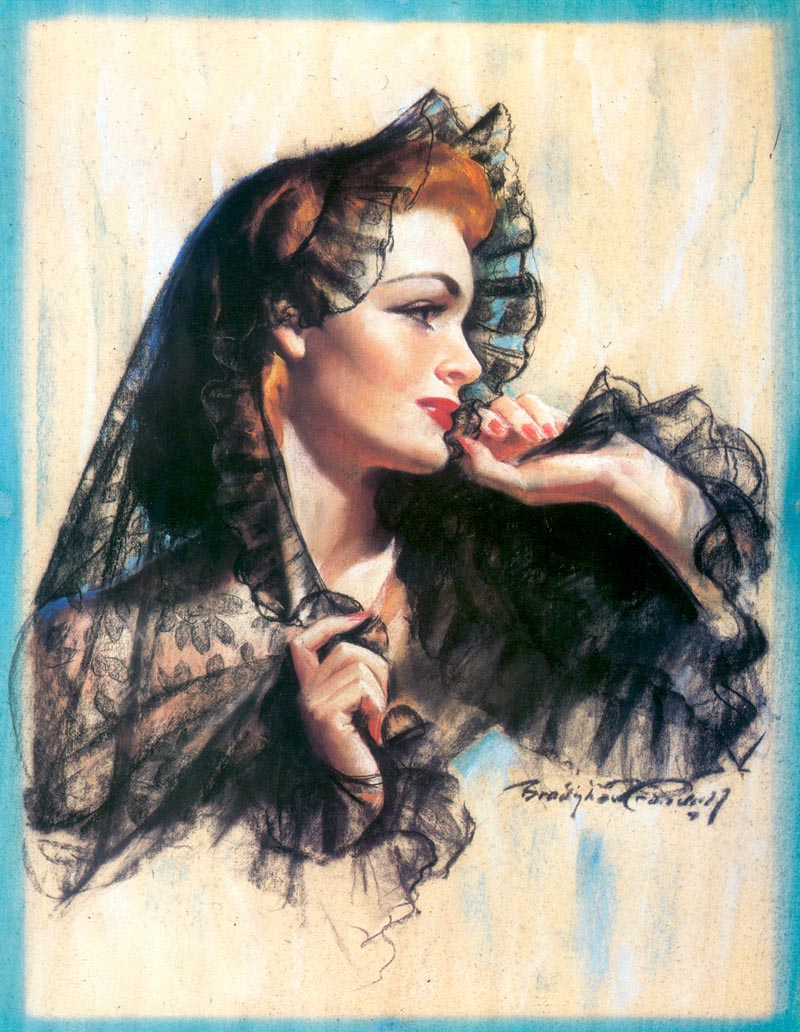By guest authorKent Steine
He was born John Bradshaw Crandell, June 14, 1896 in Glen Falls, New York.

(Above: Of Bette Davis, Crandell remarked, "She was a swell model, and was always on time." Davis sat for Crandell on three separate occasions, with each session lasting about 2 hours. He encouraged his models to talk while he worked, claiming, "It helps make the picture interesting.")
Brad, as friends knew him, became interested with art through the majestic covers of the various periodicals of the time. Magazines like Colliers, The Saturday Evening Post, Century and others were the forms of entertainment. They were as recognizable and accessible as the nightly news on television is today. And like this modern day parallel, the person who delivered this product was as important as the product itself.

(Above: This charcoal study was produced during the 1930's, and was a variation of several images ultimately used by Palmolive.)
By the time Crandell graduated from high school, he knew that he wanted to produce artwork for the covers of these great publications. After graduation, he moved to Chicago and began attending classes at the Art Institute. Although his stay there would be brief (6 months), he most likely had the opportunity to study with Vanderpoel.

(Above: Although the precise date of this little editorial piece in the NYT is unknown, the reference to Crandell taking over for Harrison Fisher at Cosmopolitan, and McClelland Barclay, respectively place this between 1935 and 1943.)
Famed anatomist John H. Vanderpoel was the drawing instructor at the Institute, and various students of his were contemporaries of Crandell's. Artists such as Rolf Armstrong and George Petty studied under Vanderpoel. The great J.C. Leyendecker himself credited Vanderpoel with much of his success as a draughtsman and illustrator.

(Above: The study presented here, was produced around 1938. It was unsigned, and possibly a preliminary sketch for a calendar reproduction. Characteristically large, at 20" x 33", it was undoubtedly drawn from life, and lighted with absolute precision.)
For reasons unknown, Crandell stopped attending classes at the "Institute", and enrolled at Wesleyan University. While he was at Wesleyan, World War I erupted in Europe. Crandell interrupted his education and enlisted in the Navy serving as a Machinist's 1st mate.

(Above: At 25 1/2" x 18 3/4", the 1940 cover of Cosmopolitan typified Brad's working dimensions for his pastel pictures. Using a variety of boards and papers, some were as large as 30" x 40".)
After a medical discharge, he returned to New York and worked in the canteen at the Bryant Park YMCA as a cashier. It was during this period he met and married Myra Clarke.
* Kent Steine is an artist, author and teacher. His renowned series of "Masters" articles for Step-By-Step magazine remain some of the best ever written on the history of illustration. With this week being the anniversary of Bradshaw Crandell's death, I'm very grateful to Kent for sharing the story of this fabulous artist with us. An abridged version of this week's series of posts originally appeared as an article in SXS magazine.
Genial.-
ReplyDelete""he most likely had the opportunity to study with Vanderpoel."" ~ That is most improbable, Crandell was 15 when Vanderpoel died (May 2, 1911) while on a year's leave of absence to teach in St. Louis.
ReplyDeleteThis comment has been removed by the author.
ReplyDeleteLeif---regarding the caricature of Crandell, it's actually from a syndicated caricature feature called 'Major Operations' which was drawn by world renowned quick sketch caricaturist Henry Major during the 1930's.
ReplyDelete'Bugs' Baer was the writer...
It also didn't run in the NYT's as it was a Hearst feature. The strip ran primarily in their papers...